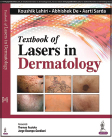Translate this page into:
Textbook of lasers in dermatology
Correspondence Address:
Sujay Khandpur
Professor, Department of Dermatology and Venereology, All India Institute of Medical Sciences, New Delhi - 110 029
India
| How to cite this article: Khandpur S. Textbook of lasers in dermatology. Indian J Dermatol Venereol Leprol 2016;82:752-753 |
Authors: Koushik Lahiri, Abhishek De, Aarti Sarda
Publisher: Jaypee Brothers Medical Publishers Pvt Ltd, New Delhi, India
ISBN: 978-93-85999-62-8
Edition:First edition
Pages: 312
Price: Rs. 3495/-

In the present era of technological advancement and open market economy, when every device and equipment can be easily accessed and acquired, the attraction and desire to use it has tremendously increased in the past decade. One observes this trend in the field of dermatology as well and lures every interventionist to operate such equipments especially in situ ations that are beyond the scope of medical management. The laser is one such device that has flooded the global and the Indian market in the past 5 years. The zest and enthusiasm to use it especially when a wide variety and combinations of laser systems are available, sometimes leads to inappropriate use and overtreatment of skin conditions. At such a crucial and mystifying period, when the subject of dermatology is trying to perform the balancing act between the traditional and the modern, conventional and aggressive and cautious and uncompromising, it was imperative that a Textbook on Lasers be published that provides a scientific, logical and an honest view on the subject. This book edited by Lahiri et al. has to a large extent served the purpose by presenting the subject of cutaneous lasers in a simple, illustrative and unpretentious style.
This multi-authored textbook that has incorporated the views and experiences of experts from all over the world, has an attractive persona by way of a colorful cover which is hardbound. This along with good quality thick paper makes it easy to maintain. The dedication made by all the editors to their parents in the beginning, reflects a task well begun. The various chapters have been chosen methodically and placed in the correct order that makes for simple and logical reading. The “blue-black” color scheme gives it a scientific look, the font size of the titles, subtitles and the text is appropriate and makes it very readable. Several complex concepts have been simplified by putting them in point form and supplementing them with schematic line diagrams. Placement of boxes and tables in between the text facilitates easy reading, quick reference and recapitulation. The chapters on Evidence based approach for the treatment of various dermatoses by lasers deserve special mention and appreciation. Considerable research and effort has been undertaken by the authors to highlight the advantages and drawbacks and therefore put in to perspective the relevance of the different laser systems in various dermatoses. Citing of comparative trials between the various devices for a particular indication adds value to the book.
Just as any maiden venture has some flaws, there are some inaccuracies in the book too, which if amended by more robust and vigorous editing, would certainly enhance its significance. There are some grammatical and typographic errors, some sentences are not properly structured that affects the flow of reading, in some tables, there is mismatch between the columns and their headings, occasional legends and images are incorrectly written and labeled and quality, placement and orientation of some pre- and post treatment images could be improved.
Overall, this textbook gives a comprehensive view of lasers in skin diseases and certainly achieves the daunting task of taking a scientific position on the utility of this very popular and remunerative therapeutic modality for skin diseases.
Fulltext Views
16,954
PDF downloads
5,095





